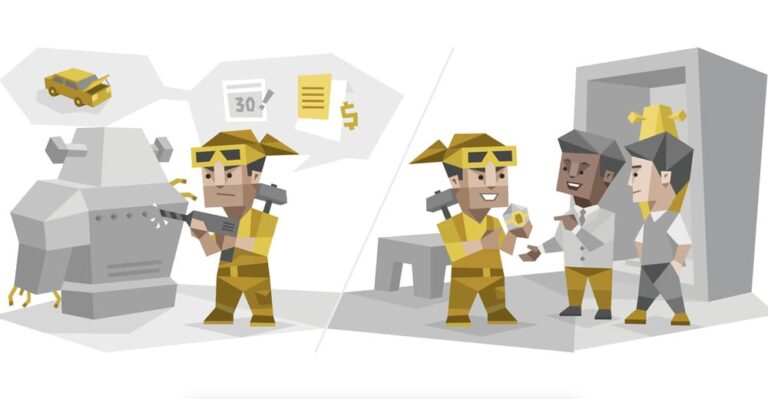Daftar Isi
- Apa Itu Metode Waterfall?
- Tahapan dalam Metode Waterfall
- Kapan Sebaiknya Menggunakan Metode Waterfall?
- Keuntungan Menggunakan Metode Waterfall
- Tantangan dalam Menggunakan Metode Waterfall
- Metode Waterfall vs. Agile: Mana yang Lebih Cocok untuk Proyek Kamu?
- Mengapa Metode Waterfall Penting untuk Bisnis Kamu?
- Analisis Kebutuhan
Di tahap pertama ini, semua kebutuhan proyek diidentifikasi dan dicatat secara detail. Jadi, tim dan klien bisa punya pemahaman yang sama sebelum mulai. Semua spesifikasi harus jelas di awal, supaya nggak ada kebingungan di tengah jalan. - Desain Sistem dan Perangkat Lunak
Setelah kebutuhan sudah ditetapkan, masuk ke tahap desain. Di sini, tim membuat perencanaan teknis yang meliputi struktur sistem, antarmuka pengguna, dan lainnya. Desain ini akan jadi acuan tim pengembang buat mulai kerja di tahap berikutnya. - Implementasi atau Pengembangan
Pada tahap ini, tim mulai menulis kode dan membangun sistem berdasarkan desain yang sudah disepakati. Karena semua langkah sudah diatur dari awal, implementasinya tinggal mengikuti panduan desain. - Pengujian
Setelah pengembangan selesai, saatnya diuji untuk memastikan sistem berfungsi sesuai rencana. Pengujian ini penting untuk memastikan produk bebas dari error dan siap dipakai. - Implementasi Sistem
Setelah lolos pengujian, sistem akan diluncurkan ke lingkungan produksi. Di sini, pengguna bisa mulai mengakses dan menggunakan sistem. - Pemeliharaan
Terakhir, sistem akan dipelihara secara berkala, termasuk perbaikan bug dan peningkatan fitur kalau dibutuhkan.
Dengan tahapan yang jelas, metode waterfall membantu tim untuk bekerja dengan terstruktur dan terdokumentasi, bikin proyek lebih terkontrol dan terarah.
- Spesifikasi yang Stabil – Kalau kebutuhan proyek bisa ditentukan dari awal dan nggak banyak berubah, metode ini ideal banget.
- Batas Waktu yang Jelas – Waterfall cocok buat proyek yang punya jadwal ketat karena setiap tahap punya alur yang teratur.
- Keterlibatan Klien yang Nggak Terlalu Tinggi – Kalau proyek nggak butuh banyak masukan dari klien di setiap tahap, metode ini bisa jadi pilihan yang praktis.
Sebagai contoh, metode ini sering dipakai di proyek konstruksi, di mana setiap tahap harus selesai sebelum lanjut ke tahap berikutnya, dan spesifikasi biasanya jarang berubah.
- Struktur yang Jelas dan Terorganisir
Setiap fase sudah ditentukan dari awal, jadi tim bisa mengikuti alurnya tanpa harus bingung. Dengan struktur yang rapi, proyek jadi lebih mudah dipantau. - Dokumentasi yang Lengkap
Setiap tahap di metode waterfall didokumentasikan dengan baik. Dokumentasi ini membantu tim memahami detail proyek dan jadi acuan di masa mendatang, khususnya kalau ada anggota tim baru yang perlu cepat paham. - Mudah Dimonitor dan Dievaluasi
Karena bergerak secara linear, setiap tahap bisa dievaluasi lebih mudah, bikin manajer proyek lebih gampang memantau progres dan kinerja tim. - Efisiensi Waktu dan Biaya
Untuk proyek dengan kebutuhan stabil, waterfall membantu menjaga waktu dan biaya tetap terkontrol karena minim perubahan di tengah jalan. Ini tentunya menguntungkan, terutama buat perusahaan dengan anggaran ketat.
- Kurang Fleksibel
Kalau ada perubahan di tengah proyek, waterfall bisa jadi nggak fleksibel. Revisi atau perubahan besar biasanya menambah biaya dan waktu. - Biaya Revisi yang Tinggi
Karena setiap tahap harus selesai sebelum lanjut, kalau ada perubahan besar di akhir, biaya revisi jadi lebih tinggi dan butuh waktu ekstra. - Keterbatasan Umpan Balik Klien
Umpan balik dari klien atau pengguna sering kali baru didapat setelah proyek selesai. Ini bisa jadi masalah kalau hasil akhir ternyata nggak sesuai harapan.
Tingkatkan Proyek Kamu Bersama Noethera
Hubungi kami hari ini untuk konsultasi gratis dan lihat bagaimana layanan kami bisa mendukung keberhasilan proyek dan bisnis kamu!










